Travellers Rest |
||||
 |
 |
|||
Knitted sweater for men in DROPS Soft Tweed and DROPS Kid-Silk. The piece is worked bottom up with high neck. Sizes S - XXXL.
DROPS 233-8 |
||||
|
------------------------------------------------------- EXPLANATIONS FOR THE PATTERN: ------------------------------------------------------- RIDGE/GARTER STITCH (worked back and forth): Knit all rows. 1 ridge = knit 2 rows. NECK-DISPLACEMENTS: LEFT FRONT PIECE: Decrease 1 stitch before the marker and increase 1 stitch after the marker as follows: Work until there are 3 stitches left before the marker, knit 2 together, knit 2 (marker is between these 2 stitches), make 1 yarn over. NOTE: To avoid the rib becoming tight, increase 1 stitch (without decreasing) every 3rd increase/decrease. The yarn overs are worked twisted on the next row and worked into the rib (knit 1/purl 3 seen from the right side). Work as follows: ROW 1: Increase and decrease ROWS 2-4: Work as before ROW 5: Increase and decrease ROWS 6-8: Work as before ROW 9: Increase and decrease ROW 10: Work as before ROW 11: Increase ROW 12: Work as before. Repeat these 12 rows. RIGHT FRONT PIECE: Decrease 1 stitch before the marker and increase 1 stitch after the marker as follows: Work until there is 1 stitch left before the marker, make 1 yarn over, knit 2 (marker is between these 2 stitches), slip 1 stitch as if to knit, knit 1 and pass the slipped stitch over the knitted stitch. Increase and decrease in the same way as on the left front piece. BUTTONHOLES: Work buttonholes on the right band. 1 BUTTONHOLE = knit together the 3rd and 4th stitch from the edge and make 1 yarn over. On the next row knit the yarn over to leave a hole. Work buttonholes when the piece measures: S: 44, 51, 59 and 67 cm = 17¼", 20", 23¼" and 26⅜" M: 46, 53, 61 and 69 cm = 18", 21", 24" and 27⅛" L: 48, 55, 63 and 71 cm = 19", 21⅝", 24¾" and 28" XL: 49, 57, 65 and 73 cm = 19¼", 22½", 25½" and 28¾" XXL: 51, 59, 67 and 75 cm = 20", 23¼", 26⅜" and 29½" XXXL: 53, 61, 69 and 77 cm = 21", 24", 27⅛" and 30⅜" The last buttonhole is worked when the neck measures 6 cm = 2⅜". INCREASE TIP (sleeves): Start 1 stitch before the marker thread, make 1 yarn over, knit 2 (marker thread sits between these 2 stitches), 1 yarn over. On the next round knit the yarn overs twisted to avoid holes. ------------------------------------------------------- START THE PIECE HERE: ------------------------------------------------------- SWEATER – SHORT OVERVIEW OF THE PIECE: The piece is worked back and forth in sections then sewn together. The neck-line is worked with displaced stitches, giving more ribbed stitches in front and less stockinette stitches at the sides. The neck is worked to finish. The sleeves are worked bottom up, in the round, with double pointed needles/short circular needle. BACK PIECE: Cast on 87-96-102-111-120-129 stitches with circular needle size 4 MM = US 6 and 1 strand DROPS Soft Tweed and 1 strand DROPS Kid-Silk. Purl 1 row from the wrong side. Work rib as follows: 1 edge stitch in GARTER STITCH – read description above, * knit 1, purl 2 *, work from *-* until there are 2 stitches left, knit 1, 1 edge stitch in garter stitch. Continue this rib back and forth for 8 cm = 3⅛". Knit 1 row from the right side and decrease 9-10-10-11-10-11 stitches evenly spaced = 78-86-92-100-110-118 stitches. Change to circular needle size 5mm. Work stockinette stitch with 1 garter stitch on each side. REMEMBER THE KNITTING GAUGE! When the piece measures 46-47-48-49-50-51 cm = 18"-18½"-19"-19¼"-19¾"-20", bind off 2-5-6-8-12-14 stitches at the beginning of the next 2 rows for the armholes = 74-76-80-84-86-90 stitches. Continue with stockinette stitch and 1 garter stitch on each side. When the piece measures 64-66-68-70-72-74 cm = 25¼"-26"-26¾"-27½"-28⅜"-29⅛", bind off the middle 36-36-36-42-42-42 stitches for the neck and finish each shoulder separately. Bind off 1 stitch on the next row from the neck = 18-19-21-20-21-23 stitches. Continue with stockinette stitch and 1 garter stitch on each side until the piece measures 66-68-70-72-74-76 cm = 26"-26¾"-27½"-28⅜"-29⅛"-29½". Bind off. Work the other shoulder in the same way. FRONT PIECE: Cast on and work in the same way as the back piece until the front measures 43-45-47-48-50-52 cm = 17"-17¾"-18½"-19"-19¾"-20½" = 78-86-92-100-110-118 stitches. Now divide for the neck. Place the last 39-43-46-50-55-59 stitches on a thread and work the first 39-43-46-50-55-59 stitches as follows: LEFT FRONT PIECE: The first row is worked from the right side: 1 edge stitch in garter stitch, stockinette stitch over the next 31-35-38-42-47-51 stitches, purl 3, knit 1, 3 garter stitches, then cast on 4 stitches at the end of the row = 43-47-50-54-59-63 stitches. Wrong side: 7 band stitches in garter stitch, purl 1, knit 3, purl 2 and insert a marker between these 2 stitches, work to the end of the row. Continue this pattern and work NECK-DISPLACEMENTS – read description above (remember to bind off for the armhole as described below). Increase 1 stitch and decrease 1 stitch every 4th row (= every 2nd row from the right side) 12-12-12-15-15-15 times. NOTE! In addition increase 1 extra stitch 4-4-4-5-5-5 times. The rib increases mid-front and the stockinette stitch decreases towards the side. Increase and decrease on each side of 2 stockinette stitches (marker sits between these 2 stitches); this creates a diagonal line up the shoulder. AT THE SAME TIME when the piece measures 46-47-48-49-50-51 cm = 18"-18½"-19"-19¼"-19¾"-20" bind off 2-5-6-8-12-14 stitches from the side for the armhole. When the neck displacements are finished there are 45-46-48-51-52-54 stitches. Continue working until the piece measures 66-68-70-72-74-76 cm = 26"-26¾"-27½"-28⅜"-29⅛"-29½", bind off 18-19-21-20-21-23 stitches from the side = 27-27-27-31-31-31 stitches. Lay the piece to one side and work the right front piece. RIGHT FRONT PIECE: Cast on 4 stitches and place the 39-43-46-50-55-59 stitches from the thread back on the needle. Work as follows: 3 stitches in garter stitch, knit 1, purl 3, work stockinette stitch until there is 1 stitch left, 1 edge stitch in garter stitch = 43-47-50-54-59-63 stitches. Wrong side: 1 edge stitch in garter stitch, stockinette stitch until there are 13 stitches left, purl 2 and insert a marker between these 2 stitches, knit 3, purl 1 and 7 band stitches in garter stitch. Continue this pattern and work NECK-DISPLACEMENTS - (remember to bind off for the armhole as described below). Increase 1 stitch and decrease 1 stitch every 4th row (= every 2nd row from the right side) 12-12-12-15-15-15 times. NOTE! In addition increase 1 extra stitch 4-4-4-5-5-5 times. The rib increases mid-front and the stockinette stitch decreases towards the side. Increase and decrease on each side of 2 stockinette stitches (marker between these 2 stitches); this creates a diagonal line up the shoulder. In addition work the BUTTONHOLES – read description above. AT THE SAME TIME when the piece measures 46-47-48-49-50-51 cm = 18"-18½"-19"-19¼"-19¾"-20", bind off 2-5-6-8-12-14 stitches from the side for the armhole. When the neck displacements are finished there are 45-46-48-51-52-54 stitches. Continue working until the piece measures 66-68-70-72-74-76 cm = 26"-26¾"-27½"-28⅜"-29⅛"-29½", bind off 18-19-21-20-21-23 stitches from the side = 27-27-27-31-31-31 stitches. Lay the piece to one side. SLEEVES: Cast on 45-45-48-48-51-54 stitches with double pointed needles size 4 MM = US 6 and 1 strand of each quality (2 strands). Knit 1 round, then work rib (knit 1, purl 2). When the piece measures 8 cm = 3⅛", change to double pointed needles size 5 MM = US 8. Insert a marker thread at the beginning of the round = mid-under sleeve. Continue with stockinette stitch. AT THE SAME TIME when the piece measures 11-12-11-12-11-13 cm = 4⅜"-4¾"-4⅜"-4¾"-4⅜"-5⅛", increase 1 stitch on each side of the marker thread – read INCREASE TIP. Increase like this every 4½-3½-3½-3-3-2½ cm = 1⅝"-1¼"-1¼"-1⅛"-1⅛"-1" a total of 10-12-12-13-13-13 times = 65-69-72-74-77-80 stitches. When the sleeve measures 56-54-53-52-49-48 cm = 22"-21¼"-21"-20½"-19¼"-19", continue back and forth for the sleeve cap (from mid-under sleeve) until the sleeve measures 57 cm = 22½" in all sizes (a split of 1-3-4-5-8-9 cm = ⅜"-1⅛"-1½"-2"-3⅛"-3½"). Cast off. Work the other sleeve in the same way. ASSEMBLY: Sew the shoulder seams. Sew the sleeve caps to the armholes, then the openings at the bottom of the armholes – see sketch. Sew the side seams, leaving an 8 cm = 3⅛" split at the bottom. NECK: Place the 27-27-27-31-31-31 stitches from each front piece on circular needle size 4 MM = US 6 and knit up 37-37-37-45-45-45 stitches along the top of the back piece = 91-91-91-107-107-107 stitches. Work as follows from the wrong side: 7 band stitches in garter stitch, * purl 1, knit 3 *, work from *-* until there are 8 stitches left, purl 1 and 7 band stitches in garter stitch. Work this rib for 8 cm = 3⅛", bind off with knit over knit and purl over purl. Lay the right band over the left band at the bottom of the neck and sew together. Sew the buttons onto the left band. |
||||
Diagram explanations |
||||
|
||||
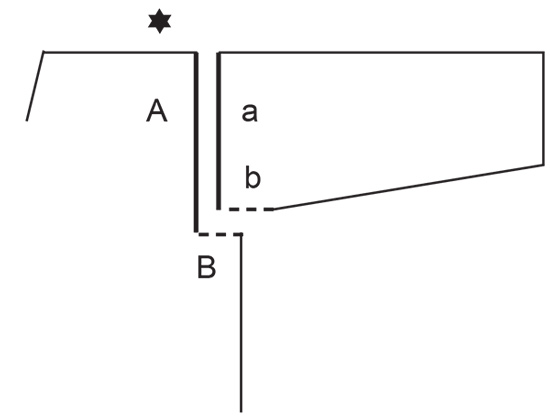
|
||||
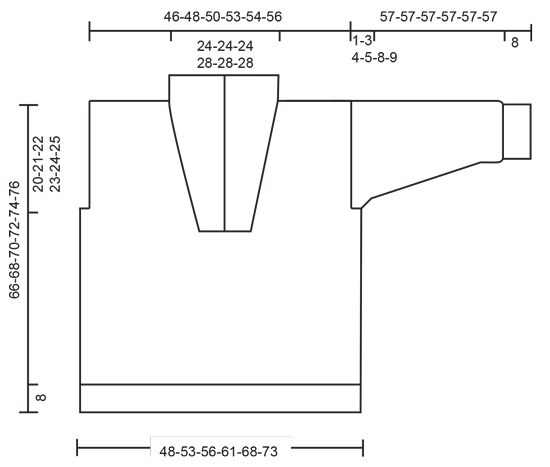
|
||||
|
Have you made this or any other of our designs? Tag your pictures in social media with #dropsdesign so we can see them! Do you need help with this pattern?You'll find tutorial videos, a Comments/Questions area and more by visiting the pattern on garnstudio.com. © 1982-2024 DROPS Design A/S. We reserve all rights. This document, including all its sub-sections, has copyrights. Read more about what you can do with our patterns at the bottom of each pattern on our site. |
||||








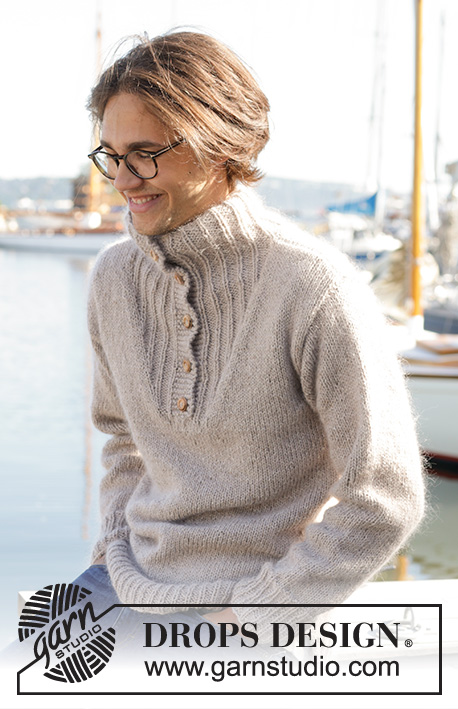
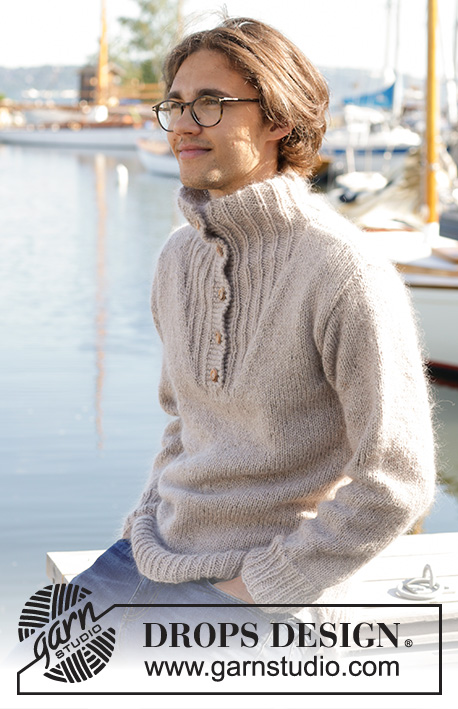



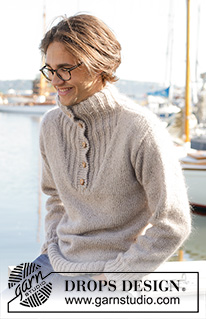



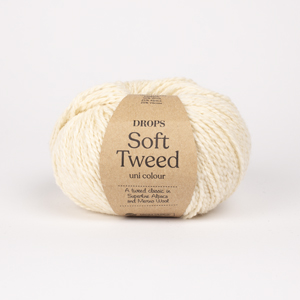

























































Comments / Questions (23)
Hi can you please clarify Left side, neck displacement NOTE! in addition you increase an extra stitch 4-4-4-5-5-5 times where is this and how please, many thanks, Jane.
24.01.2024 - 14:30DROPS Design answered:
Dear Mrs Wragg, this increase (without decrease) is explained under row 11 under NECK DISPLACMENTS, this means you will increase exactly as before, but this increase will not be compensated by a decrease and will increase the number of sts on needle. Happy knitting!
25.01.2024 - 08:21For drops travellers rest pattern why do i need soft tweed AND kids silk yarn. I can't see mention of changing yarn in the pattern.Thanks
19.01.2024 - 20:07DROPS Design answered:
Hi Carole, DROPS Kid Silk gives the garment special softenes and kind of fluffiness. We do not change yarns while knitting, but knit with both threads at the same time, so whole sweater is knitted with double yarn. Happy knitting!
20.01.2024 - 14:46Les explications indiquent 4 boutonnières alors que le pull montre 5 boutons. Il manque l'indication de la dernière boutonnière, non ?
02.11.2023 - 00:07DROPS Design answered:
Bonjour Mme Francesconi, la dernière boutonnière se fait quand le col mesure 6 cm, autrement dit dans la partie COL. Bon tricot!
02.11.2023 - 18:13Excusez moi, encore une question : devant droit, on tricote jusqu'à ce que l'ouvrage mesure 72 cm. Devant gauche, la où il y a les boutonnières, en xl jusqu'à 73 cm. Est-ce correct ? 1 cm de plus ? Merci encore une fois de votre aide.
27.10.2023 - 12:40DROPS Design answered:
Bonjour Mme Francesconi, vous tricotez bien les 2 devants jusqu'à 72 cm pour que les épaules aient la même hauteur que le dos, les 2 dernières boutonnières se font sur le col: la 1ère 1 cm après avoir repris les mailles du col et la 2ème quand le col mesure 6 cm. Bon tricot!
28.10.2023 - 08:26Je commence donc à augmenter ma maille supplémentaire à partir du 11eme rang, je fais donc 2 jetés à la suite ?
25.10.2023 - 10:16DROPS Design answered:
Bonjour Mme Francesconi, lorsque vous faites le décalage, votre nombre de mailles ne change pas, mais comme vous augmentez d'un côté et diminuez de l'autre, vous décalez les côtes. En revanche, quand vous tricotez le 11ème des 12 rangs, vous augmentez 1 maille comme avant (= 1 seule maile), et vous ne diminuez pas = vous augmentez bien 1 maille. Bon tricot!
25.10.2023 - 15:18Bonjour, Pour DECALAGE DU COL DEVANT GAUCHE : NOTE : Augmenter 1 maille supplémentaire. Ou l'augmenter ? Après le marqueur ? Après chaque 3ème augm/dim cad pour commencer au 9ème rang ? Merci d'avance pour votre aide.
24.10.2023 - 21:40DROPS Design answered:
Bonjour Mme Francesconi, toutes les augmentations se font au même niveau, mais pour cette augmentation supplémentaire, on ne fait pas de diminution en même temps (cf rang 11 des 12 rangs à répéter du devant gauche). Bon tricot!
25.10.2023 - 07:42Merci pour votre réponse rapide. Mais, on peut adapter dos et devant en circulaire ? (pour éviter les coutures sur le cotés !) J'ai commencé à le faire, j'espère que ça ira....:))
19.10.2023 - 18:37DROPS Design answered:
Bonjour Mme Francesconi, tout à fait, vous pouvez adapter les explications pour tricoter le bas du pull en rond, il vous suffira alors juste de diviser pour les emmanchures pour terminer chaque partie séparément. Bon tricot!
20.10.2023 - 08:45Ireland, not UK.
19.10.2023 - 17:24I would like to knit the Travellers Rest jumper, but I have not used circular needles before. Am I needing 4 sets of circular needles (5mm/40cm and 80cm-4mm/40cm and 80cm)? I prefer to work with bamboo needles, but finding it difficult to source what I need. Any suggestions appreciated.\r\nJan
19.10.2023 - 17:23Bonjour, DOS : ...."1 m lisière au point mousse..... Continuer en côtes ainsi en allers et retours pendant 8 cm. " Mais le modèle ne se tricote pas en rond, comme les manches ? Merci d'avance pour votre réponse. Isabelle
19.10.2023 - 14:13DROPS Design answered:
Bonjour Isabelle, effectivement, le dos et le devant se tricotent en allers et retours sur aiguille circulaire, avec des coutures sur les côtés et aux épaules, on ne tricote que les manches en rond. Bon tricot!
19.10.2023 - 15:59